Climate Change Impact on India
VerifiedAdded on 2020/05/08
|9
|3777
|46
AI Summary
This assignment analyzes the multifaceted effects of climate change on India. It delves into its implications for public health, particularly concerning malaria outbreaks and temperature-related illnesses. The impact on agriculture and water resources is also explored, highlighting the vulnerability of key sectors to climate variability. Furthermore, the document discusses the nation's efforts to mitigate these challenges through initiatives like the National Action Plan on Climate Change.
Contribute Materials
Your contribution can guide someone’s learning journey. Share your
documents today.
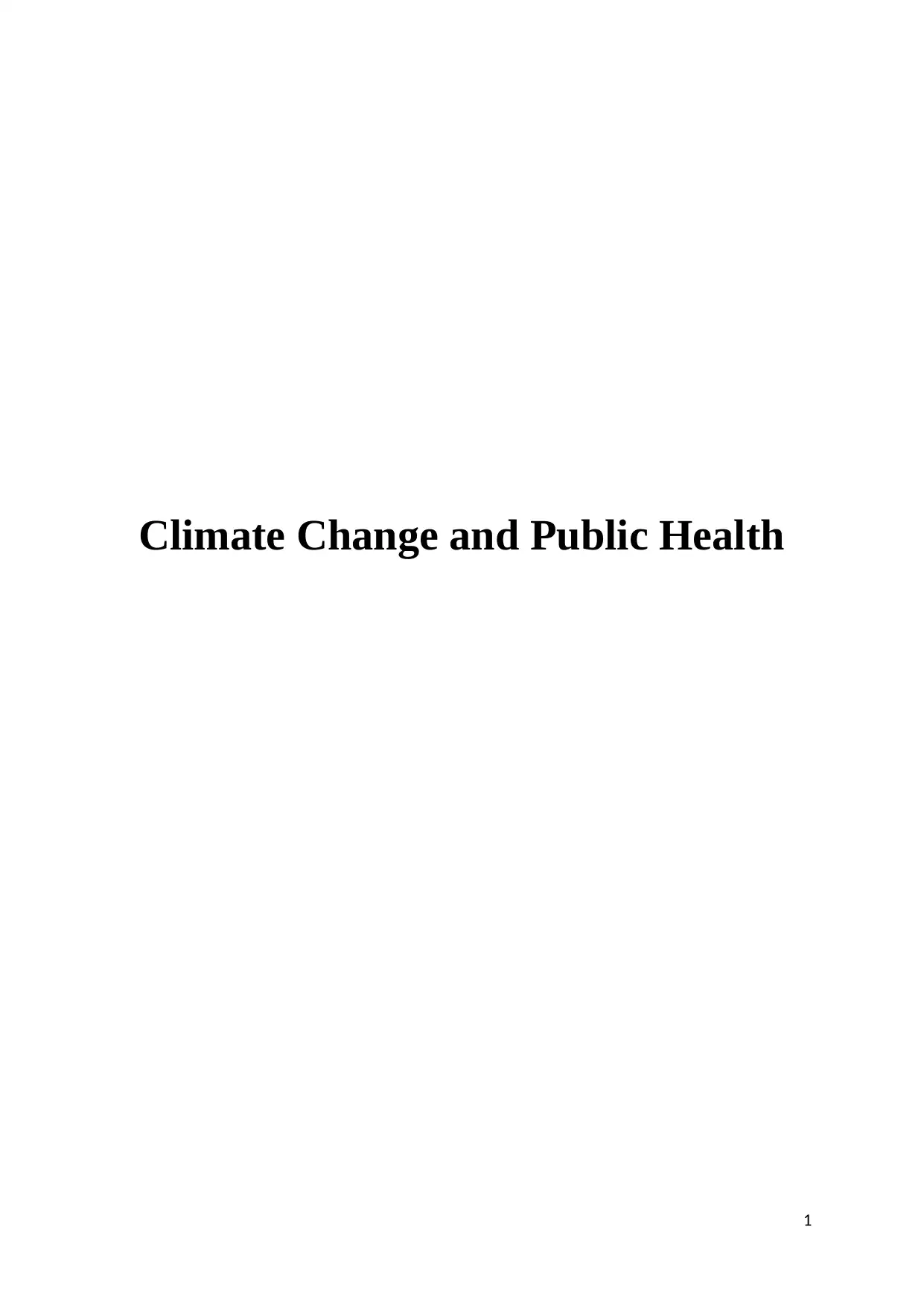
Climate Change and Public Health
1
1
Secure Best Marks with AI Grader
Need help grading? Try our AI Grader for instant feedback on your assignments.
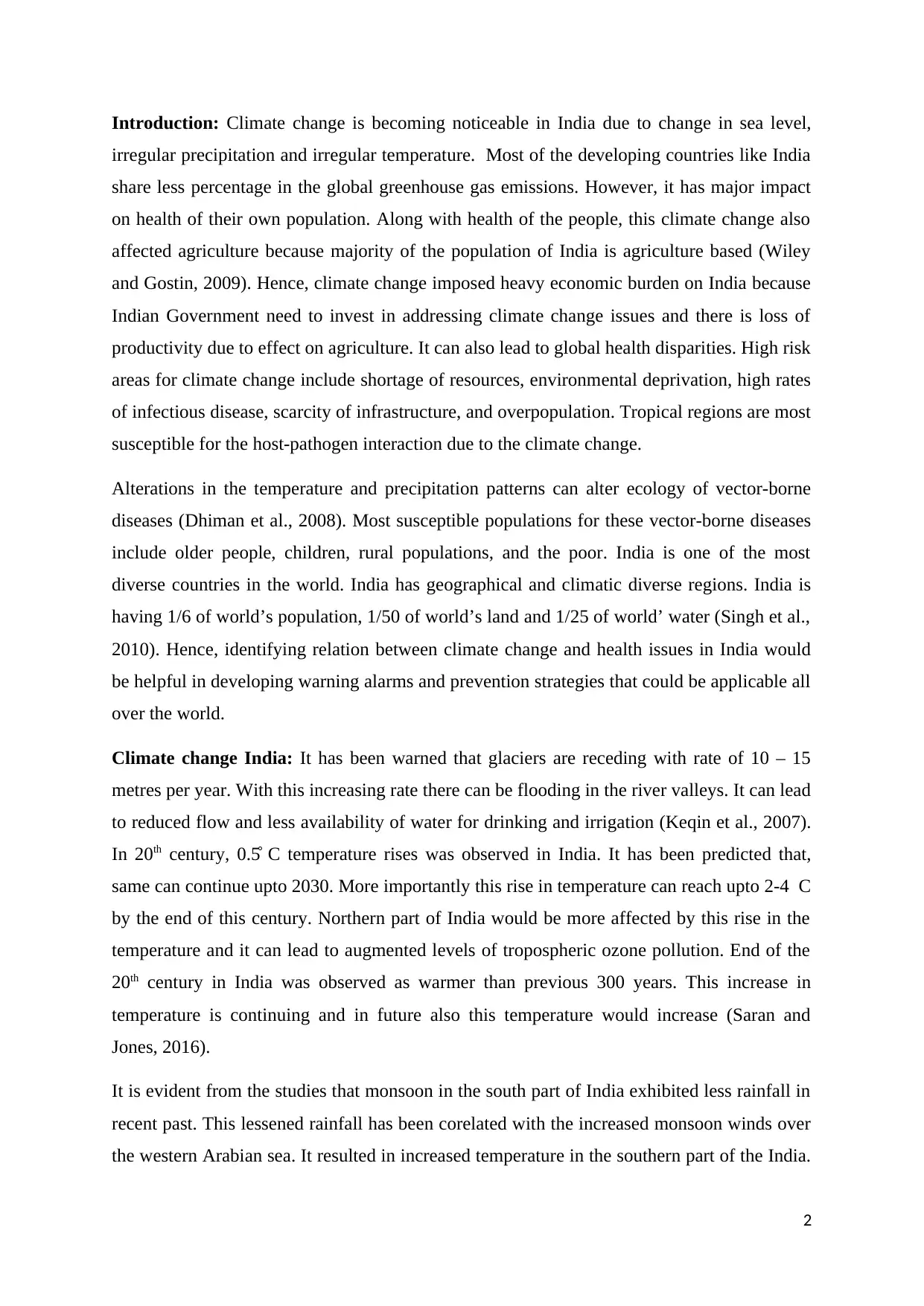
Introduction: Climate change is becoming noticeable in India due to change in sea level,
irregular precipitation and irregular temperature. Most of the developing countries like India
share less percentage in the global greenhouse gas emissions. However, it has major impact
on health of their own population. Along with health of the people, this climate change also
affected agriculture because majority of the population of India is agriculture based (Wiley
and Gostin, 2009). Hence, climate change imposed heavy economic burden on India because
Indian Government need to invest in addressing climate change issues and there is loss of
productivity due to effect on agriculture. It can also lead to global health disparities. High risk
areas for climate change include shortage of resources, environmental deprivation, high rates
of infectious disease, scarcity of infrastructure, and overpopulation. Tropical regions are most
susceptible for the host-pathogen interaction due to the climate change.
Alterations in the temperature and precipitation patterns can alter ecology of vector-borne
diseases (Dhiman et al., 2008). Most susceptible populations for these vector-borne diseases
include older people, children, rural populations, and the poor. India is one of the most
diverse countries in the world. India has geographical and climatic diverse regions. India is
having 1/6 of world’s population, 1/50 of world’s land and 1/25 of world’ water (Singh et al.,
2010). Hence, identifying relation between climate change and health issues in India would
be helpful in developing warning alarms and prevention strategies that could be applicable all
over the world.
Climate change India: It has been warned that glaciers are receding with rate of 10 – 15
metres per year. With this increasing rate there can be flooding in the river valleys. It can lead
to reduced flow and less availability of water for drinking and irrigation (Keqin et al., 2007).
In 20th century, 0.5̊ C temperature rises was observed in India. It has been predicted that,
same can continue upto 2030. More importantly this rise in temperature can reach upto 2-4 C
by the end of this century. Northern part of India would be more affected by this rise in the
temperature and it can lead to augmented levels of tropospheric ozone pollution. End of the
20th century in India was observed as warmer than previous 300 years. This increase in
temperature is continuing and in future also this temperature would increase (Saran and
Jones, 2016).
It is evident from the studies that monsoon in the south part of India exhibited less rainfall in
recent past. This lessened rainfall has been corelated with the increased monsoon winds over
the western Arabian sea. It resulted in increased temperature in the southern part of the India.
2
irregular precipitation and irregular temperature. Most of the developing countries like India
share less percentage in the global greenhouse gas emissions. However, it has major impact
on health of their own population. Along with health of the people, this climate change also
affected agriculture because majority of the population of India is agriculture based (Wiley
and Gostin, 2009). Hence, climate change imposed heavy economic burden on India because
Indian Government need to invest in addressing climate change issues and there is loss of
productivity due to effect on agriculture. It can also lead to global health disparities. High risk
areas for climate change include shortage of resources, environmental deprivation, high rates
of infectious disease, scarcity of infrastructure, and overpopulation. Tropical regions are most
susceptible for the host-pathogen interaction due to the climate change.
Alterations in the temperature and precipitation patterns can alter ecology of vector-borne
diseases (Dhiman et al., 2008). Most susceptible populations for these vector-borne diseases
include older people, children, rural populations, and the poor. India is one of the most
diverse countries in the world. India has geographical and climatic diverse regions. India is
having 1/6 of world’s population, 1/50 of world’s land and 1/25 of world’ water (Singh et al.,
2010). Hence, identifying relation between climate change and health issues in India would
be helpful in developing warning alarms and prevention strategies that could be applicable all
over the world.
Climate change India: It has been warned that glaciers are receding with rate of 10 – 15
metres per year. With this increasing rate there can be flooding in the river valleys. It can lead
to reduced flow and less availability of water for drinking and irrigation (Keqin et al., 2007).
In 20th century, 0.5̊ C temperature rises was observed in India. It has been predicted that,
same can continue upto 2030. More importantly this rise in temperature can reach upto 2-4 C
by the end of this century. Northern part of India would be more affected by this rise in the
temperature and it can lead to augmented levels of tropospheric ozone pollution. End of the
20th century in India was observed as warmer than previous 300 years. This increase in
temperature is continuing and in future also this temperature would increase (Saran and
Jones, 2016).
It is evident from the studies that monsoon in the south part of India exhibited less rainfall in
recent past. This lessened rainfall has been corelated with the increased monsoon winds over
the western Arabian sea. It resulted in increased temperature in the southern part of the India.
2

Since, 1970s, there is upward trend in the tropical storms and hurricanes in India. These
storm were with longer duration and greater intensity and these occurred mainly due to
increase in the tropical sea surface temperature (Ghosh, 2016). In last 50 years it has been
observed that warm extremes are associated with more heat waves and cold extremes were
warmed more as compared to the warm extremes. Hence, there were less frost days. This
resulted in the increased frequency of heavy precipitation. Between 1900 to 1999, there was
consistent warming in upper 100 m tropical and eastern subtropical Indian ocean. This
warming was less during 1900 to 1970, however between 1971 to 1999, there was significant
increase in temperature. In few of these decades, increase in temperature was more than 0.2̊
C. Between, 1900 to 2005, there was increase in precipitation by 20 % per century. However,
there was dramatic decrease in the precipitation from 1979 to 2005 (Dubash, 2012).
As India is geographically diverse country, in different states light variation in the temperate
and rainfall were observed over the period of 1951-2010. In states like Punjab and Haryana
there was decrease in temperature of 0.01̊C per year, while in states like Himachal Pradesh
there was increase in temperature by 0.06̊ C per year. Average increase in temperature in
India between 1951-2010 was 0.01 C per year. It was observed that between 1951-2010,
there was increase in rainfall in in state like West Bengal by +3.63 mm/year, while there was
decrease in rainfall in states like Utter Pradesh and Andaman and Nicobar by 4.42 and 7.77
mm/year respectively. Average decrease in rainfall in India between 1951-2010 was 2.21
mm/year. Climate change varied in India based on the season. There was increase in
temperature by 0.01C per year between 1951-210 in monsoon season. In winter season, this
increase in temperature was by 0.02C per year from 1951-2010. Reverse trend was observed
in terms of rainfall in summer and monsoon season in India in last 50 years. There was
increase in rainfall in summer season by 0.33 mm/year from 1951-2010, while there was
decrease in rainfall in monsoon season by 0.70 mm/year from 1951-2010. It has been
predicted that, there would be slight decrease in the precipitation in the initial decades.
However, by 2100, there would be overall increase in rain in India. By 2050, there would be
reduced rainy days in a year, however, there would be increase in days with extreme rainfall
on a single day (Malone and and Brenkert, 2008; O’Brien et al., 2004; Singh et al., 2011).
3
storm were with longer duration and greater intensity and these occurred mainly due to
increase in the tropical sea surface temperature (Ghosh, 2016). In last 50 years it has been
observed that warm extremes are associated with more heat waves and cold extremes were
warmed more as compared to the warm extremes. Hence, there were less frost days. This
resulted in the increased frequency of heavy precipitation. Between 1900 to 1999, there was
consistent warming in upper 100 m tropical and eastern subtropical Indian ocean. This
warming was less during 1900 to 1970, however between 1971 to 1999, there was significant
increase in temperature. In few of these decades, increase in temperature was more than 0.2̊
C. Between, 1900 to 2005, there was increase in precipitation by 20 % per century. However,
there was dramatic decrease in the precipitation from 1979 to 2005 (Dubash, 2012).
As India is geographically diverse country, in different states light variation in the temperate
and rainfall were observed over the period of 1951-2010. In states like Punjab and Haryana
there was decrease in temperature of 0.01̊C per year, while in states like Himachal Pradesh
there was increase in temperature by 0.06̊ C per year. Average increase in temperature in
India between 1951-2010 was 0.01 C per year. It was observed that between 1951-2010,
there was increase in rainfall in in state like West Bengal by +3.63 mm/year, while there was
decrease in rainfall in states like Utter Pradesh and Andaman and Nicobar by 4.42 and 7.77
mm/year respectively. Average decrease in rainfall in India between 1951-2010 was 2.21
mm/year. Climate change varied in India based on the season. There was increase in
temperature by 0.01C per year between 1951-210 in monsoon season. In winter season, this
increase in temperature was by 0.02C per year from 1951-2010. Reverse trend was observed
in terms of rainfall in summer and monsoon season in India in last 50 years. There was
increase in rainfall in summer season by 0.33 mm/year from 1951-2010, while there was
decrease in rainfall in monsoon season by 0.70 mm/year from 1951-2010. It has been
predicted that, there would be slight decrease in the precipitation in the initial decades.
However, by 2100, there would be overall increase in rain in India. By 2050, there would be
reduced rainy days in a year, however, there would be increase in days with extreme rainfall
on a single day (Malone and and Brenkert, 2008; O’Brien et al., 2004; Singh et al., 2011).
3
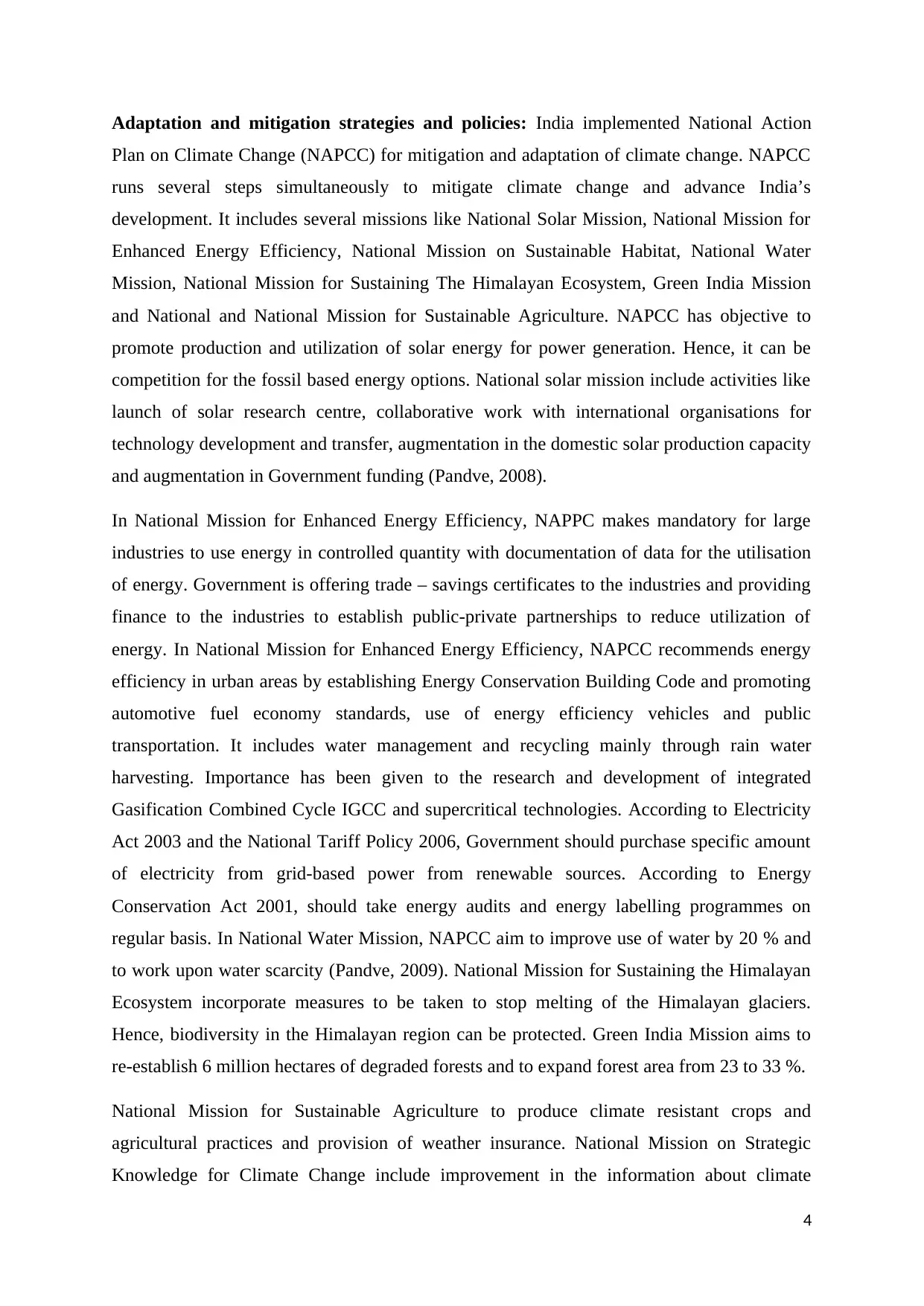
Adaptation and mitigation strategies and policies: India implemented National Action
Plan on Climate Change (NAPCC) for mitigation and adaptation of climate change. NAPCC
runs several steps simultaneously to mitigate climate change and advance India’s
development. It includes several missions like National Solar Mission, National Mission for
Enhanced Energy Efficiency, National Mission on Sustainable Habitat, National Water
Mission, National Mission for Sustaining The Himalayan Ecosystem, Green India Mission
and National and National Mission for Sustainable Agriculture. NAPCC has objective to
promote production and utilization of solar energy for power generation. Hence, it can be
competition for the fossil based energy options. National solar mission include activities like
launch of solar research centre, collaborative work with international organisations for
technology development and transfer, augmentation in the domestic solar production capacity
and augmentation in Government funding (Pandve, 2008).
In National Mission for Enhanced Energy Efficiency, NAPPC makes mandatory for large
industries to use energy in controlled quantity with documentation of data for the utilisation
of energy. Government is offering trade – savings certificates to the industries and providing
finance to the industries to establish public-private partnerships to reduce utilization of
energy. In National Mission for Enhanced Energy Efficiency, NAPCC recommends energy
efficiency in urban areas by establishing Energy Conservation Building Code and promoting
automotive fuel economy standards, use of energy efficiency vehicles and public
transportation. It includes water management and recycling mainly through rain water
harvesting. Importance has been given to the research and development of integrated
Gasification Combined Cycle IGCC and supercritical technologies. According to Electricity
Act 2003 and the National Tariff Policy 2006, Government should purchase specific amount
of electricity from grid-based power from renewable sources. According to Energy
Conservation Act 2001, should take energy audits and energy labelling programmes on
regular basis. In National Water Mission, NAPCC aim to improve use of water by 20 % and
to work upon water scarcity (Pandve, 2009). National Mission for Sustaining the Himalayan
Ecosystem incorporate measures to be taken to stop melting of the Himalayan glaciers.
Hence, biodiversity in the Himalayan region can be protected. Green India Mission aims to
re-establish 6 million hectares of degraded forests and to expand forest area from 23 to 33 %.
National Mission for Sustainable Agriculture to produce climate resistant crops and
agricultural practices and provision of weather insurance. National Mission on Strategic
Knowledge for Climate Change include improvement in the information about climate
4
Plan on Climate Change (NAPCC) for mitigation and adaptation of climate change. NAPCC
runs several steps simultaneously to mitigate climate change and advance India’s
development. It includes several missions like National Solar Mission, National Mission for
Enhanced Energy Efficiency, National Mission on Sustainable Habitat, National Water
Mission, National Mission for Sustaining The Himalayan Ecosystem, Green India Mission
and National and National Mission for Sustainable Agriculture. NAPCC has objective to
promote production and utilization of solar energy for power generation. Hence, it can be
competition for the fossil based energy options. National solar mission include activities like
launch of solar research centre, collaborative work with international organisations for
technology development and transfer, augmentation in the domestic solar production capacity
and augmentation in Government funding (Pandve, 2008).
In National Mission for Enhanced Energy Efficiency, NAPPC makes mandatory for large
industries to use energy in controlled quantity with documentation of data for the utilisation
of energy. Government is offering trade – savings certificates to the industries and providing
finance to the industries to establish public-private partnerships to reduce utilization of
energy. In National Mission for Enhanced Energy Efficiency, NAPCC recommends energy
efficiency in urban areas by establishing Energy Conservation Building Code and promoting
automotive fuel economy standards, use of energy efficiency vehicles and public
transportation. It includes water management and recycling mainly through rain water
harvesting. Importance has been given to the research and development of integrated
Gasification Combined Cycle IGCC and supercritical technologies. According to Electricity
Act 2003 and the National Tariff Policy 2006, Government should purchase specific amount
of electricity from grid-based power from renewable sources. According to Energy
Conservation Act 2001, should take energy audits and energy labelling programmes on
regular basis. In National Water Mission, NAPCC aim to improve use of water by 20 % and
to work upon water scarcity (Pandve, 2009). National Mission for Sustaining the Himalayan
Ecosystem incorporate measures to be taken to stop melting of the Himalayan glaciers.
Hence, biodiversity in the Himalayan region can be protected. Green India Mission aims to
re-establish 6 million hectares of degraded forests and to expand forest area from 23 to 33 %.
National Mission for Sustainable Agriculture to produce climate resistant crops and
agricultural practices and provision of weather insurance. National Mission on Strategic
Knowledge for Climate Change include improvement in the information about climate
4
Secure Best Marks with AI Grader
Need help grading? Try our AI Grader for instant feedback on your assignments.

science, its impacts and challenges. It also includes plans to tackle these challenges through
Climate Science Research Fund. NAPCC also incorporates provision of health care services
and assessment of disease burden due to climate change. Prime Minister's Council on Climate
Change monitor all the activities of NAPCC on regular basis (Pandve, 2007).
Malaria: Alterations in the temperatures and precipitation can lead to change in ecology of
vector-borne disease like malaria. Stagnant water can aid favourable place for breeding place
for mosquitoes. Temperature alterations, air pollution, waterborne diseases are mainly
responsible for malaria. Malaria parasite and mosquito both are susceptible to the alteration in
temperature. At places with less temperature, even with small increase in temperature can
increase rate of malaria transmission due to augmented number of mosquitos (O’Neill and
Ebi, 2009). Deforestation and irrigation act as open places for the multiplication of malaria
vectors and increase its transmission. This multifactorial transmission of malaria is the main
hindrance for predicting exact cases of malaria.
Variability of rainfall in the different regions of India is responsible for approximately 45 %
variability in the malaria transmission. High density population is also one of the prominent
reasons for epidemic of malaria in India (Dhiman et al., 2010). Approximately 2 million
cases of malaria are there in India. Prevalence of infectious disease varies according to the
regions. According to WHO estimates, every year approximately 15000 people die due to
malaria in India. However, in another study, it was estimated that approximately 200000
deaths occur due malaria before 70 years of age and approximately 55000 deaths occur as
child (Dhingra et al., 2010). Accurate estimation of death in India is difficult because malaria
is mistaken for life-threatening fever in India. Moreover, appropriate medical attention at the
time of death is not evident in rural areas. Hence, in developing countries like India it would
be difficult to estimate hospital-based deaths due to malaria because of climate change.
Approximately 65 % cases of malaria are evident in states like Orissa, Jharkhand, Madya
Pradesh, Chhattisgarh, West Bengal, and the North East. Sub-Saharan Africa region is
considered as most prevalent region malaria. However, it is evident that Orissa is more
prevalent than Sub-Saharan Africa (Kumar et al., 2007; Narain, 2007).
Cases of disability-adjusted life years are more due to vector-borne disease. Out of these,
approximately half of the cases are due to malaria (Dash, 2008). Drug resistant strains of
malaria parasites are mainly responsible for more prevalence of malaria in India. Plasmodium
falciparum is the most virulent form of parasite in India. However, after 1973 chloroquine
5
Climate Science Research Fund. NAPCC also incorporates provision of health care services
and assessment of disease burden due to climate change. Prime Minister's Council on Climate
Change monitor all the activities of NAPCC on regular basis (Pandve, 2007).
Malaria: Alterations in the temperatures and precipitation can lead to change in ecology of
vector-borne disease like malaria. Stagnant water can aid favourable place for breeding place
for mosquitoes. Temperature alterations, air pollution, waterborne diseases are mainly
responsible for malaria. Malaria parasite and mosquito both are susceptible to the alteration in
temperature. At places with less temperature, even with small increase in temperature can
increase rate of malaria transmission due to augmented number of mosquitos (O’Neill and
Ebi, 2009). Deforestation and irrigation act as open places for the multiplication of malaria
vectors and increase its transmission. This multifactorial transmission of malaria is the main
hindrance for predicting exact cases of malaria.
Variability of rainfall in the different regions of India is responsible for approximately 45 %
variability in the malaria transmission. High density population is also one of the prominent
reasons for epidemic of malaria in India (Dhiman et al., 2010). Approximately 2 million
cases of malaria are there in India. Prevalence of infectious disease varies according to the
regions. According to WHO estimates, every year approximately 15000 people die due to
malaria in India. However, in another study, it was estimated that approximately 200000
deaths occur due malaria before 70 years of age and approximately 55000 deaths occur as
child (Dhingra et al., 2010). Accurate estimation of death in India is difficult because malaria
is mistaken for life-threatening fever in India. Moreover, appropriate medical attention at the
time of death is not evident in rural areas. Hence, in developing countries like India it would
be difficult to estimate hospital-based deaths due to malaria because of climate change.
Approximately 65 % cases of malaria are evident in states like Orissa, Jharkhand, Madya
Pradesh, Chhattisgarh, West Bengal, and the North East. Sub-Saharan Africa region is
considered as most prevalent region malaria. However, it is evident that Orissa is more
prevalent than Sub-Saharan Africa (Kumar et al., 2007; Narain, 2007).
Cases of disability-adjusted life years are more due to vector-borne disease. Out of these,
approximately half of the cases are due to malaria (Dash, 2008). Drug resistant strains of
malaria parasites are mainly responsible for more prevalence of malaria in India. Plasmodium
falciparum is the most virulent form of parasite in India. However, after 1973 chloroquine
5
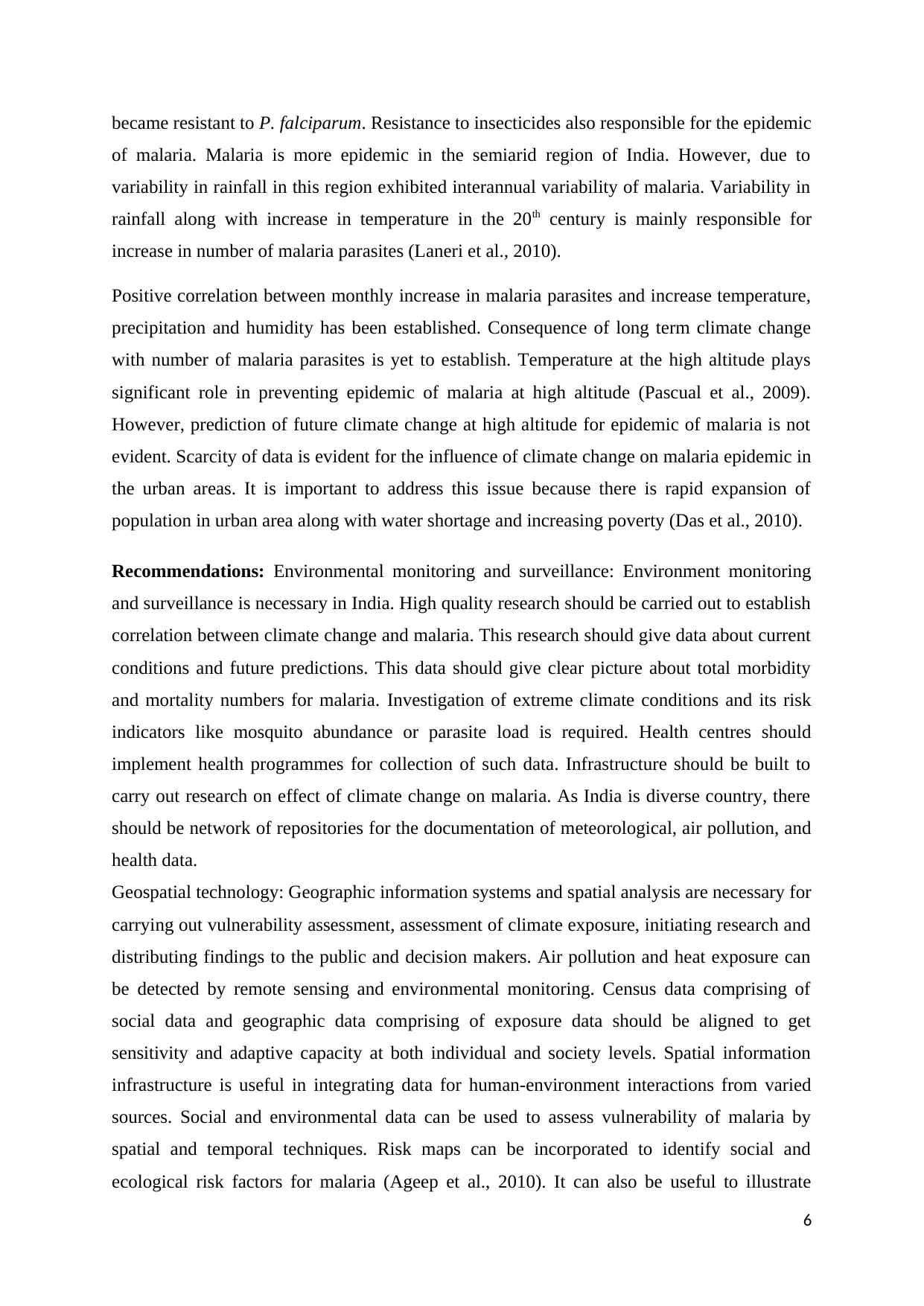
became resistant to P. falciparum. Resistance to insecticides also responsible for the epidemic
of malaria. Malaria is more epidemic in the semiarid region of India. However, due to
variability in rainfall in this region exhibited interannual variability of malaria. Variability in
rainfall along with increase in temperature in the 20th century is mainly responsible for
increase in number of malaria parasites (Laneri et al., 2010).
Positive correlation between monthly increase in malaria parasites and increase temperature,
precipitation and humidity has been established. Consequence of long term climate change
with number of malaria parasites is yet to establish. Temperature at the high altitude plays
significant role in preventing epidemic of malaria at high altitude (Pascual et al., 2009).
However, prediction of future climate change at high altitude for epidemic of malaria is not
evident. Scarcity of data is evident for the influence of climate change on malaria epidemic in
the urban areas. It is important to address this issue because there is rapid expansion of
population in urban area along with water shortage and increasing poverty (Das et al., 2010).
Recommendations: Environmental monitoring and surveillance: Environment monitoring
and surveillance is necessary in India. High quality research should be carried out to establish
correlation between climate change and malaria. This research should give data about current
conditions and future predictions. This data should give clear picture about total morbidity
and mortality numbers for malaria. Investigation of extreme climate conditions and its risk
indicators like mosquito abundance or parasite load is required. Health centres should
implement health programmes for collection of such data. Infrastructure should be built to
carry out research on effect of climate change on malaria. As India is diverse country, there
should be network of repositories for the documentation of meteorological, air pollution, and
health data.
Geospatial technology: Geographic information systems and spatial analysis are necessary for
carrying out vulnerability assessment, assessment of climate exposure, initiating research and
distributing findings to the public and decision makers. Air pollution and heat exposure can
be detected by remote sensing and environmental monitoring. Census data comprising of
social data and geographic data comprising of exposure data should be aligned to get
sensitivity and adaptive capacity at both individual and society levels. Spatial information
infrastructure is useful in integrating data for human-environment interactions from varied
sources. Social and environmental data can be used to assess vulnerability of malaria by
spatial and temporal techniques. Risk maps can be incorporated to identify social and
ecological risk factors for malaria (Ageep et al., 2010). It can also be useful to illustrate
6
of malaria. Malaria is more epidemic in the semiarid region of India. However, due to
variability in rainfall in this region exhibited interannual variability of malaria. Variability in
rainfall along with increase in temperature in the 20th century is mainly responsible for
increase in number of malaria parasites (Laneri et al., 2010).
Positive correlation between monthly increase in malaria parasites and increase temperature,
precipitation and humidity has been established. Consequence of long term climate change
with number of malaria parasites is yet to establish. Temperature at the high altitude plays
significant role in preventing epidemic of malaria at high altitude (Pascual et al., 2009).
However, prediction of future climate change at high altitude for epidemic of malaria is not
evident. Scarcity of data is evident for the influence of climate change on malaria epidemic in
the urban areas. It is important to address this issue because there is rapid expansion of
population in urban area along with water shortage and increasing poverty (Das et al., 2010).
Recommendations: Environmental monitoring and surveillance: Environment monitoring
and surveillance is necessary in India. High quality research should be carried out to establish
correlation between climate change and malaria. This research should give data about current
conditions and future predictions. This data should give clear picture about total morbidity
and mortality numbers for malaria. Investigation of extreme climate conditions and its risk
indicators like mosquito abundance or parasite load is required. Health centres should
implement health programmes for collection of such data. Infrastructure should be built to
carry out research on effect of climate change on malaria. As India is diverse country, there
should be network of repositories for the documentation of meteorological, air pollution, and
health data.
Geospatial technology: Geographic information systems and spatial analysis are necessary for
carrying out vulnerability assessment, assessment of climate exposure, initiating research and
distributing findings to the public and decision makers. Air pollution and heat exposure can
be detected by remote sensing and environmental monitoring. Census data comprising of
social data and geographic data comprising of exposure data should be aligned to get
sensitivity and adaptive capacity at both individual and society levels. Spatial information
infrastructure is useful in integrating data for human-environment interactions from varied
sources. Social and environmental data can be used to assess vulnerability of malaria by
spatial and temporal techniques. Risk maps can be incorporated to identify social and
ecological risk factors for malaria (Ageep et al., 2010). It can also be useful to illustrate
6
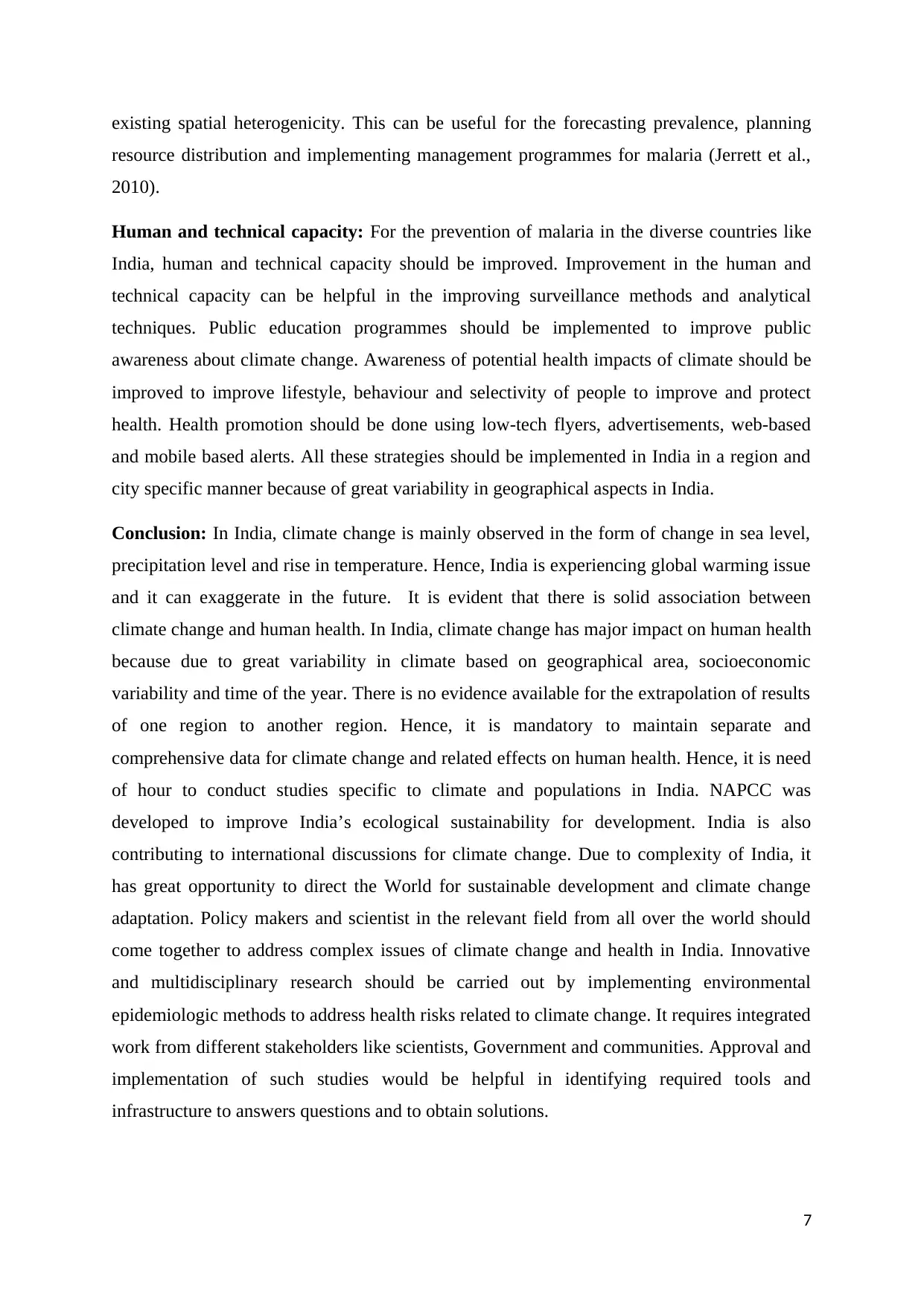
existing spatial heterogenicity. This can be useful for the forecasting prevalence, planning
resource distribution and implementing management programmes for malaria (Jerrett et al.,
2010).
Human and technical capacity: For the prevention of malaria in the diverse countries like
India, human and technical capacity should be improved. Improvement in the human and
technical capacity can be helpful in the improving surveillance methods and analytical
techniques. Public education programmes should be implemented to improve public
awareness about climate change. Awareness of potential health impacts of climate should be
improved to improve lifestyle, behaviour and selectivity of people to improve and protect
health. Health promotion should be done using low-tech flyers, advertisements, web-based
and mobile based alerts. All these strategies should be implemented in India in a region and
city specific manner because of great variability in geographical aspects in India.
Conclusion: In India, climate change is mainly observed in the form of change in sea level,
precipitation level and rise in temperature. Hence, India is experiencing global warming issue
and it can exaggerate in the future. It is evident that there is solid association between
climate change and human health. In India, climate change has major impact on human health
because due to great variability in climate based on geographical area, socioeconomic
variability and time of the year. There is no evidence available for the extrapolation of results
of one region to another region. Hence, it is mandatory to maintain separate and
comprehensive data for climate change and related effects on human health. Hence, it is need
of hour to conduct studies specific to climate and populations in India. NAPCC was
developed to improve India’s ecological sustainability for development. India is also
contributing to international discussions for climate change. Due to complexity of India, it
has great opportunity to direct the World for sustainable development and climate change
adaptation. Policy makers and scientist in the relevant field from all over the world should
come together to address complex issues of climate change and health in India. Innovative
and multidisciplinary research should be carried out by implementing environmental
epidemiologic methods to address health risks related to climate change. It requires integrated
work from different stakeholders like scientists, Government and communities. Approval and
implementation of such studies would be helpful in identifying required tools and
infrastructure to answers questions and to obtain solutions.
7
resource distribution and implementing management programmes for malaria (Jerrett et al.,
2010).
Human and technical capacity: For the prevention of malaria in the diverse countries like
India, human and technical capacity should be improved. Improvement in the human and
technical capacity can be helpful in the improving surveillance methods and analytical
techniques. Public education programmes should be implemented to improve public
awareness about climate change. Awareness of potential health impacts of climate should be
improved to improve lifestyle, behaviour and selectivity of people to improve and protect
health. Health promotion should be done using low-tech flyers, advertisements, web-based
and mobile based alerts. All these strategies should be implemented in India in a region and
city specific manner because of great variability in geographical aspects in India.
Conclusion: In India, climate change is mainly observed in the form of change in sea level,
precipitation level and rise in temperature. Hence, India is experiencing global warming issue
and it can exaggerate in the future. It is evident that there is solid association between
climate change and human health. In India, climate change has major impact on human health
because due to great variability in climate based on geographical area, socioeconomic
variability and time of the year. There is no evidence available for the extrapolation of results
of one region to another region. Hence, it is mandatory to maintain separate and
comprehensive data for climate change and related effects on human health. Hence, it is need
of hour to conduct studies specific to climate and populations in India. NAPCC was
developed to improve India’s ecological sustainability for development. India is also
contributing to international discussions for climate change. Due to complexity of India, it
has great opportunity to direct the World for sustainable development and climate change
adaptation. Policy makers and scientist in the relevant field from all over the world should
come together to address complex issues of climate change and health in India. Innovative
and multidisciplinary research should be carried out by implementing environmental
epidemiologic methods to address health risks related to climate change. It requires integrated
work from different stakeholders like scientists, Government and communities. Approval and
implementation of such studies would be helpful in identifying required tools and
infrastructure to answers questions and to obtain solutions.
7
Paraphrase This Document
Need a fresh take? Get an instant paraphrase of this document with our AI Paraphraser
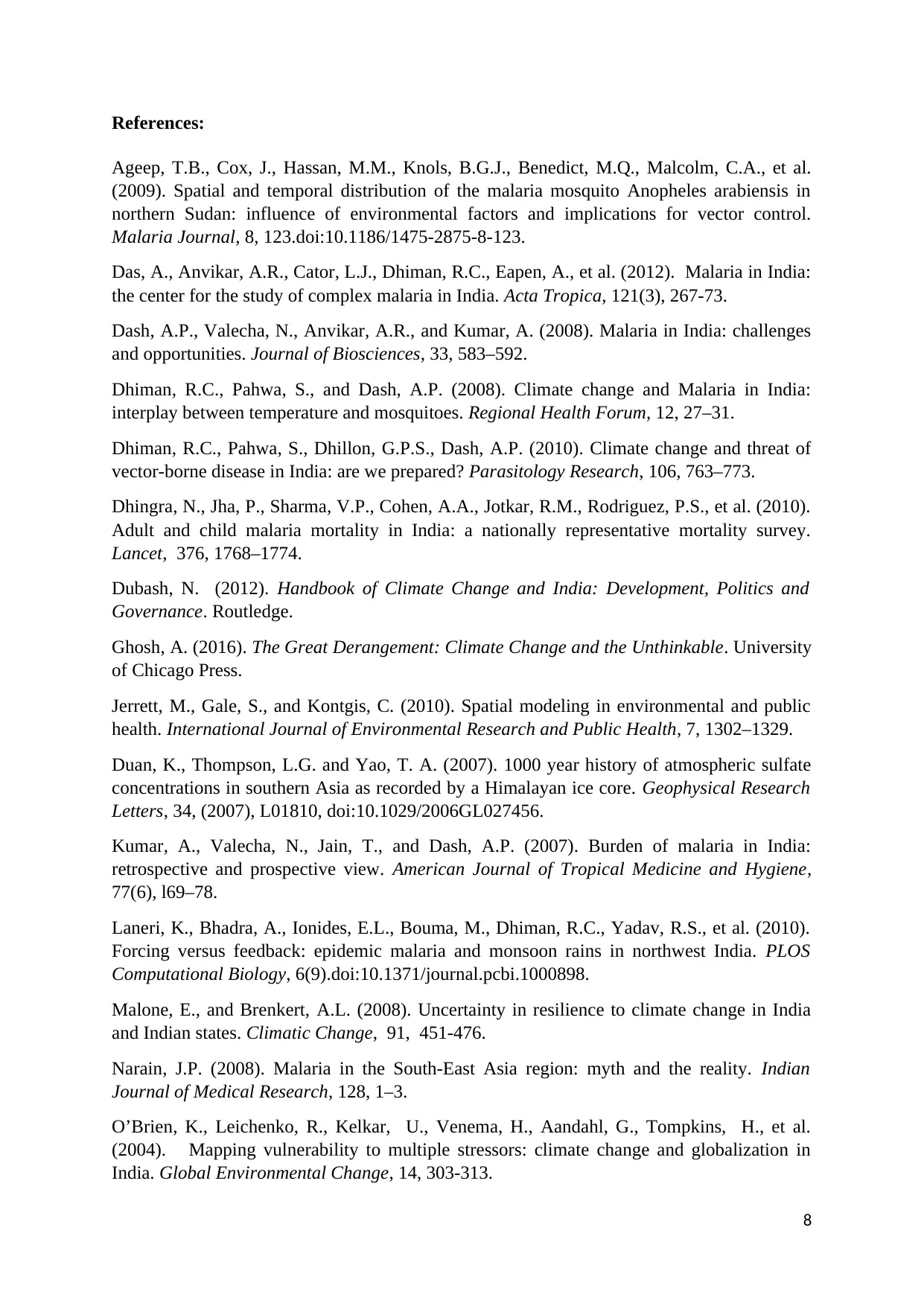
References:
Ageep, T.B., Cox, J., Hassan, M.M., Knols, B.G.J., Benedict, M.Q., Malcolm, C.A., et al.
(2009). Spatial and temporal distribution of the malaria mosquito Anopheles arabiensis in
northern Sudan: influence of environmental factors and implications for vector control.
Malaria Journal, 8, 123.doi:10.1186/1475-2875-8-123.
Das, A., Anvikar, A.R., Cator, L.J., Dhiman, R.C., Eapen, A., et al. (2012). Malaria in India:
the center for the study of complex malaria in India. Acta Tropica, 121(3), 267-73.
Dash, A.P., Valecha, N., Anvikar, A.R., and Kumar, A. (2008). Malaria in India: challenges
and opportunities. Journal of Biosciences, 33, 583–592.
Dhiman, R.C., Pahwa, S., and Dash, A.P. (2008). Climate change and Malaria in India:
interplay between temperature and mosquitoes. Regional Health Forum, 12, 27–31.
Dhiman, R.C., Pahwa, S., Dhillon, G.P.S., Dash, A.P. (2010). Climate change and threat of
vector-borne disease in India: are we prepared? Parasitology Research, 106, 763–773.
Dhingra, N., Jha, P., Sharma, V.P., Cohen, A.A., Jotkar, R.M., Rodriguez, P.S., et al. (2010).
Adult and child malaria mortality in India: a nationally representative mortality survey.
Lancet, 376, 1768–1774.
Dubash, N. (2012). Handbook of Climate Change and India: Development, Politics and
Governance. Routledge.
Ghosh, A. (2016). The Great Derangement: Climate Change and the Unthinkable. University
of Chicago Press.
Jerrett, M., Gale, S., and Kontgis, C. (2010). Spatial modeling in environmental and public
health. International Journal of Environmental Research and Public Health, 7, 1302–1329.
Duan, K., Thompson, L.G. and Yao, T. A. (2007). 1000 year history of atmospheric sulfate
concentrations in southern Asia as recorded by a Himalayan ice core. Geophysical Research
Letters, 34, (2007), L01810, doi:10.1029/2006GL027456.
Kumar, A., Valecha, N., Jain, T., and Dash, A.P. (2007). Burden of malaria in India:
retrospective and prospective view. American Journal of Tropical Medicine and Hygiene,
77(6), l69–78.
Laneri, K., Bhadra, A., Ionides, E.L., Bouma, M., Dhiman, R.C., Yadav, R.S., et al. (2010).
Forcing versus feedback: epidemic malaria and monsoon rains in northwest India. PLOS
Computational Biology, 6(9).doi:10.1371/journal.pcbi.1000898.
Malone, E., and Brenkert, A.L. (2008). Uncertainty in resilience to climate change in India
and Indian states. Climatic Change, 91, 451-476.
Narain, J.P. (2008). Malaria in the South-East Asia region: myth and the reality. Indian
Journal of Medical Research, 128, 1–3.
O’Brien, K., Leichenko, R., Kelkar, U., Venema, H., Aandahl, G., Tompkins, H., et al.
(2004). Mapping vulnerability to multiple stressors: climate change and globalization in
India. Global Environmental Change, 14, 303-313.
8
Ageep, T.B., Cox, J., Hassan, M.M., Knols, B.G.J., Benedict, M.Q., Malcolm, C.A., et al.
(2009). Spatial and temporal distribution of the malaria mosquito Anopheles arabiensis in
northern Sudan: influence of environmental factors and implications for vector control.
Malaria Journal, 8, 123.doi:10.1186/1475-2875-8-123.
Das, A., Anvikar, A.R., Cator, L.J., Dhiman, R.C., Eapen, A., et al. (2012). Malaria in India:
the center for the study of complex malaria in India. Acta Tropica, 121(3), 267-73.
Dash, A.P., Valecha, N., Anvikar, A.R., and Kumar, A. (2008). Malaria in India: challenges
and opportunities. Journal of Biosciences, 33, 583–592.
Dhiman, R.C., Pahwa, S., and Dash, A.P. (2008). Climate change and Malaria in India:
interplay between temperature and mosquitoes. Regional Health Forum, 12, 27–31.
Dhiman, R.C., Pahwa, S., Dhillon, G.P.S., Dash, A.P. (2010). Climate change and threat of
vector-borne disease in India: are we prepared? Parasitology Research, 106, 763–773.
Dhingra, N., Jha, P., Sharma, V.P., Cohen, A.A., Jotkar, R.M., Rodriguez, P.S., et al. (2010).
Adult and child malaria mortality in India: a nationally representative mortality survey.
Lancet, 376, 1768–1774.
Dubash, N. (2012). Handbook of Climate Change and India: Development, Politics and
Governance. Routledge.
Ghosh, A. (2016). The Great Derangement: Climate Change and the Unthinkable. University
of Chicago Press.
Jerrett, M., Gale, S., and Kontgis, C. (2010). Spatial modeling in environmental and public
health. International Journal of Environmental Research and Public Health, 7, 1302–1329.
Duan, K., Thompson, L.G. and Yao, T. A. (2007). 1000 year history of atmospheric sulfate
concentrations in southern Asia as recorded by a Himalayan ice core. Geophysical Research
Letters, 34, (2007), L01810, doi:10.1029/2006GL027456.
Kumar, A., Valecha, N., Jain, T., and Dash, A.P. (2007). Burden of malaria in India:
retrospective and prospective view. American Journal of Tropical Medicine and Hygiene,
77(6), l69–78.
Laneri, K., Bhadra, A., Ionides, E.L., Bouma, M., Dhiman, R.C., Yadav, R.S., et al. (2010).
Forcing versus feedback: epidemic malaria and monsoon rains in northwest India. PLOS
Computational Biology, 6(9).doi:10.1371/journal.pcbi.1000898.
Malone, E., and Brenkert, A.L. (2008). Uncertainty in resilience to climate change in India
and Indian states. Climatic Change, 91, 451-476.
Narain, J.P. (2008). Malaria in the South-East Asia region: myth and the reality. Indian
Journal of Medical Research, 128, 1–3.
O’Brien, K., Leichenko, R., Kelkar, U., Venema, H., Aandahl, G., Tompkins, H., et al.
(2004). Mapping vulnerability to multiple stressors: climate change and globalization in
India. Global Environmental Change, 14, 303-313.
8
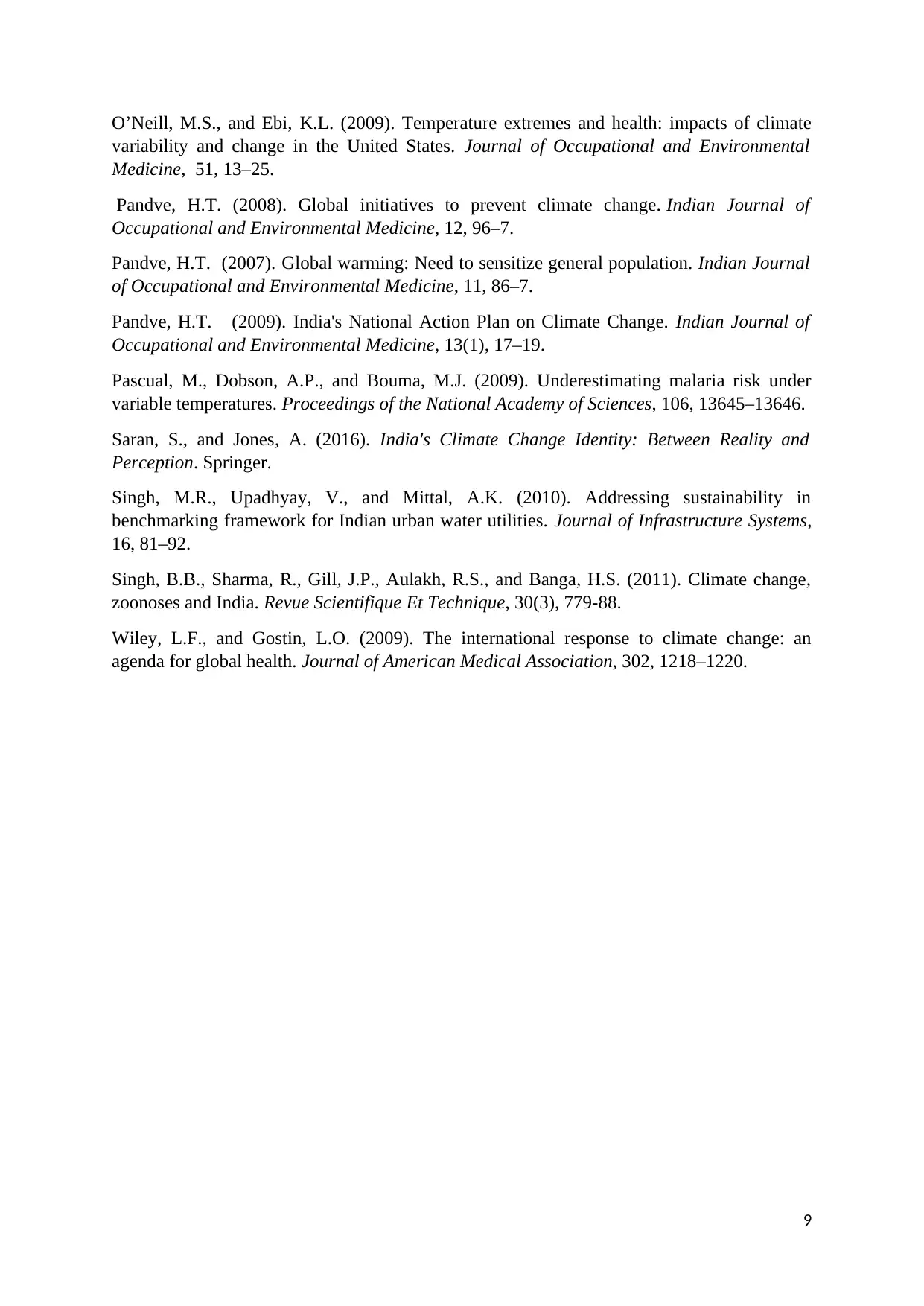
O’Neill, M.S., and Ebi, K.L. (2009). Temperature extremes and health: impacts of climate
variability and change in the United States. Journal of Occupational and Environmental
Medicine, 51, 13–25.
Pandve, H.T. (2008). Global initiatives to prevent climate change. Indian Journal of
Occupational and Environmental Medicine, 12, 96–7.
Pandve, H.T. (2007). Global warming: Need to sensitize general population. Indian Journal
of Occupational and Environmental Medicine, 11, 86–7.
Pandve, H.T. (2009). India's National Action Plan on Climate Change. Indian Journal of
Occupational and Environmental Medicine, 13(1), 17–19.
Pascual, M., Dobson, A.P., and Bouma, M.J. (2009). Underestimating malaria risk under
variable temperatures. Proceedings of the National Academy of Sciences, 106, 13645–13646.
Saran, S., and Jones, A. (2016). India's Climate Change Identity: Between Reality and
Perception. Springer.
Singh, M.R., Upadhyay, V., and Mittal, A.K. (2010). Addressing sustainability in
benchmarking framework for Indian urban water utilities. Journal of Infrastructure Systems,
16, 81–92.
Singh, B.B., Sharma, R., Gill, J.P., Aulakh, R.S., and Banga, H.S. (2011). Climate change,
zoonoses and India. Revue Scientifique Et Technique, 30(3), 779-88.
Wiley, L.F., and Gostin, L.O. (2009). The international response to climate change: an
agenda for global health. Journal of American Medical Association, 302, 1218–1220.
9
variability and change in the United States. Journal of Occupational and Environmental
Medicine, 51, 13–25.
Pandve, H.T. (2008). Global initiatives to prevent climate change. Indian Journal of
Occupational and Environmental Medicine, 12, 96–7.
Pandve, H.T. (2007). Global warming: Need to sensitize general population. Indian Journal
of Occupational and Environmental Medicine, 11, 86–7.
Pandve, H.T. (2009). India's National Action Plan on Climate Change. Indian Journal of
Occupational and Environmental Medicine, 13(1), 17–19.
Pascual, M., Dobson, A.P., and Bouma, M.J. (2009). Underestimating malaria risk under
variable temperatures. Proceedings of the National Academy of Sciences, 106, 13645–13646.
Saran, S., and Jones, A. (2016). India's Climate Change Identity: Between Reality and
Perception. Springer.
Singh, M.R., Upadhyay, V., and Mittal, A.K. (2010). Addressing sustainability in
benchmarking framework for Indian urban water utilities. Journal of Infrastructure Systems,
16, 81–92.
Singh, B.B., Sharma, R., Gill, J.P., Aulakh, R.S., and Banga, H.S. (2011). Climate change,
zoonoses and India. Revue Scientifique Et Technique, 30(3), 779-88.
Wiley, L.F., and Gostin, L.O. (2009). The international response to climate change: an
agenda for global health. Journal of American Medical Association, 302, 1218–1220.
9
1 out of 9
Related Documents
Your All-in-One AI-Powered Toolkit for Academic Success.
+13062052269
info@desklib.com
Available 24*7 on WhatsApp / Email
![[object Object]](/_next/static/media/star-bottom.7253800d.svg)
Unlock your academic potential
© 2024 | Zucol Services PVT LTD | All rights reserved.





